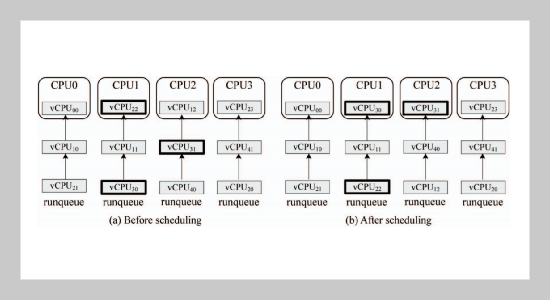REFERENCES
- [1] Uhlig, V., LeVasseur, J., Skoglund, E., et al., “Towards Scalable Multiprocessor Virtual Machines,” Proc. of 3rd Virtual Machine Research & Technology Symposium (VM’04), Berkeley, CA, USA: USENIX Association, pp. 43�56 (2004)
- [2] Weng, C., Wang, Z., Li, M., et al., “The Hybrid Scheduling Framework for Virtual Machine Systems,” Proc. of the 2009 ACM SIGPLAN/SIGOPS International Conference on Virtual Execution Environments, New York, NY, USA: ACM Press, pp. 111�120 (2009). doi: 10.1145/1508293.1508309
- [3] Chen, H., Wu, S., Di, S., et al., “Communicationdriven Scheduling for Virtual Clusters in Cloud,” Proc. of the 23rd International Symposium on High-Performance Parallel and Distributed Computing, New York, NY, USA: ACM Press, pp. 125�128 (2014). doi: 10. 1145/2600212.2600714
- [4] Wu, S., Chen, H., Di, S., et al., “Synchronization- aware Scheduling for Virtual Clusters in Cloud,” IEEE Transactions on Parallel and Distributed Systems, Vol. 26, No. 10, pp. 2890�2912 (2015). doi: 10.1109/TPDS. 2014.2359017
- [5] Kivity, A., Kamay, Y., Laor, D., et al., “kvm: the Linux Virtual Machine Monitor,” Proc. of the Linux Symposium, pp. 225�230 (2007).
- [6] Weng, C., Liu, Q., Yu, L., et al., “Dynamic Adaptive Scheduling for Virtual Machines,” Proc. of the 20th International Symposiumon High Performance Distributed Computing, New York, NY, USA: ACM Press, pp. 239�250 (2011). doi: 10.1145/1996130.1996163
- [7] Sukwong, O. and Kim, H. S., “Is Co-scheduling Too Expensive for SMPVMs?” Proc. of the 6th European Conference on Computer Systems, New York, NY, USA: ACM Press, pp. 257�272 (2011).
- [8] Kim, H., Lim, H., Jeong, J., et al., “Task-aware Virtual Machine Scheduling for I/OPerformance,” Proc. of the 2009 ACM SIGPLAN/SIGOPS International Conference on Virtual Execution Environments, New York, NY, USA: ACM Press, pp. 101�110 (2009). doi: 10. 1145/1508293.1508308
- [9] Ramachandran, A., Vienne, J., Van Der Wijngaart, R., et al., “Performance Evaluation of NAS Parallel Benchmarks on Intel Xeon Phi,” Proc. of 42nd International Conference on Parallel Processing (ICPP), IEEE, pp. 736�743 (2013). doi: 10.1109/ICPP.2013.87
- [10] Mukherjee, J., Wang, M. and Krishnamurthy, D., “Performance Testing Web Applications on the Cloud,” Proc. of IEEE Seventh International Conference on Software Testing, Verification and Validation Workshops (ICSTW), IEEE, pp. 363�369 (2014). doi: 10. 1109/ICSTW.2014.57
- [11] Bai, Y., Xu, C. and Li, Z., “Task-Aware Based Coscheduling for Virtual Machine System,” Proc. of the 2010 ACM Symposium on Applied Computing, New York, NY, USA: ACM Press, pp. 181�188 (2010). doi: 10.1145/1774088.1774126
- [12] McDougall, R. and Anderson, J., “Virtualization Performance: Perspectives and Challenges Ahead,” ACM SIGOPS Operating Systems Review, Vol. 44, No. 4, pp. 40�56 (2010). doi: 10.1145/1899928.1899933
- [13] Miao, T. and Chen, H., “FlexCore: Dynamic Virtual Machine Scheduling Using VCPU Ballooning,” Tsinghua Science and Technology, Vol. 20, No. 1, pp. 7�16 (2015). doi:10.1109/TST.2015.7040515
- [14] Li, J., Ma, R., Guan, H. B., et al., “vINT: HardwareAssisted Virtual Interrupt Remapping for SMP VM with Scheduling Awareness,” Proc. of the IEEE 7th International Conference on Cloud Computing Technology and Science (CloudCom), Vancouver, BC, Canada: IEEE, pp. 234�241 (2015). doi: 10.1109/Cloud Com.2015.18
- [15] Wang, K., Wei, Y., Xu, C. Z., et al., “Self-boosted Coscheduling for SMP Virtual Machines,” Proc. of the 2015 IEEE 23rd International Symposium on Modeling, Analysis and Simulation of Computer and Telecommunication Systems (MASCOTS), Atlanta, GA, USA: IEEE, pp. 154�163 (2015).
- [16] Wang, B., Cheng, Y., Chen, W., et al., “Efficient Consolidation-aware VCPU Scheduling on Multicore Virtualization Platform,” Future Generation Computer Systems, Vol. 56, pp. 229�237 (2016). doi: 10.1016/j. future.2015.08.007
















